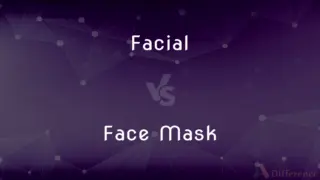Mild Steel vs. Galvanized Iron — What's the Difference?
By Tayyaba Rehman — Published on November 17, 2023
Mild steel is a low-carbon steel known for its malleability and ductility, while galvanized iron is iron or steel that has undergone a zinc coating process to resist corrosion and rust.

Difference Between Mild Steel and Galvanized Iron
Table of Contents
ADVERTISEMENT
Key Differences
Mild steel epitomizes a variation of carbon steel with a relatively low amount of carbon, making it notably malleable and ductile, thus widely applicable in various industries. In contrast, galvanized iron represents either iron or steel that has undergone a zinc-coating process, not only to prevent corrosion and rust but also to prolong its durability, especially in exterior applications.
A prominent characteristic of mild steel is its inherent vulnerability to rust when exposed to moisture or corrosive environments, which often necessitates additional treatments or coatings for applications in certain environments. Unlike mild steel, galvanized iron confidently boasts a robust defense against rust and corrosion, thanks to its protective zinc layer, making it a preferred choice in environments where moisture presence is significant.
Mild steel finds its applications in a multitude of structural applications, such as beams and columns, due to its excellent weldability and ability to withstand weight. Divergently, galvanized iron, due to its anti-corrosive properties, finds extensive application in outdoor scenarios such as roofing, piping, and fencing, ensuring longevity and sustained visual appeal even in weather-exposed conditions.
In manufacturing processes, mild steel is acknowledged for its ease of welding and forming due to its low carbon and manganese content, rendering it a preferred choice for manufacturing where shaping, bending, or welding are requisite. Galvanized iron, with its supplementary zinc layer, can be slightly more challenging to manipulate in terms of welding and forming, as the coating may be affected by high heat or deformation, potentially reducing its efficacy.
The cost-effectiveness of mild steel often makes it a go-to material for mass production and large-scale manufacturing, especially where corrosion resistance is not pivotal. Conversely, galvanized iron, while potentially incurring higher initial costs due to the galvanizing process, may prove more cost-effective in the long term in applications where resistance to weathering and corrosion are paramount.
ADVERTISEMENT
Comparison Chart
Primary Composition
Low-carbon steel
Iron or steel coated with zinc
Corrosion Resistance
Generally susceptible to corrosion
Enhanced resistance to corrosion
Common Applications
Structural elements, automobile bodies
Roofing, piping, fencing
Workability
Excellent weldability and formability
Possible challenges in welding and forming
Cost
Often less expensive initially
Can be more cost-effective long-term
Compare with Definitions
Mild Steel
A low-carbon steel variant.
Mild steel is widely used due to its excellent malleability.
Galvanized Iron
May incur higher initial costs.
Despite its cost, galvanized iron is a preferred outdoor material.
Mild Steel
Susceptible to corrosion.
Mild steel requires coatings to prevent rusting.
Galvanized Iron
Characterized by its corrosion resistance.
Galvanized iron is often used in marine environments.
Mild Steel
Notable for its ductility.
Artists often prefer mild steel for sculpting due to its ductility.
Galvanized Iron
Iron or steel coated with zinc.
Galvanized iron resists rust effectively.
Mild Steel
Cost-effective manufacturing material.
Manufacturers opt for mild steel to reduce production costs.
Galvanized Iron
Primarily used in outdoor applications.
The pipes were made of galvanized iron to prevent rusting.
Mild Steel
Exceptionally weldable material.
The structures were mainly composed of welded mild steel.
Galvanized Iron
Durable in moist environments.
Galvanized iron roofing can withstand harsh weather conditions.
Common Curiosities
Can mild steel be used in outdoor environments?
Yes, but it typically requires protective coatings to prevent corrosion.
Does mild steel offer high tensile strength?
Yes, but its tensile strength is lower compared to higher carbon steel variants.
How is galvanized iron produced?
Galvanized iron is produced by coating iron or steel with a layer of zinc.
Can galvanized iron be used structurally?
Yes, it can be used structurally, especially where corrosion resistance is crucial.
Can mild steel be easily welded?
Yes, mild steel is known for its excellent weldability.
What affects the longevity of galvanized iron?
Factors like the thickness of the zinc coating and environmental conditions.
Is mild steel naturally resistant to rust?
No, mild steel is susceptible to rust and often requires protective coatings.
Is galvanized iron always rust-proof?
It is highly resistant to rust but not completely rust-proof in all conditions.
Why choose mild steel in manufacturing?
Its malleability, ductility, and cost-effectiveness make it favorable for manufacturing.
Is the zinc coating on galvanized iron durable?
Yes, but it can degrade over time or if exposed to harsh conditions.
What impacts mild steel’s ductility?
Its low carbon content significantly contributes to its ductility.
Is mild steel suitable for high-stress applications?
It can be, but its suitability may depend on specific application requirements.
Can galvanized iron be painted?
Yes, after appropriate surface preparation, it can be painted.
How is mild steel protected from corrosion?
It's often coated with paint, galvanized, or treated with other rust inhibitors.
Where is galvanized iron commonly found?
It’s widely used in outdoor applications like roofing and fencing.
Share Your Discovery

Previous Comparison
At Your Leisure vs. At Your Convenience
Next Comparison
Facial vs. Face MaskAuthor Spotlight
Written by
Tayyaba RehmanTayyaba Rehman is a distinguished writer, currently serving as a primary contributor to askdifference.com. As a researcher in semantics and etymology, Tayyaba's passion for the complexity of languages and their distinctions has found a perfect home on the platform. Tayyaba delves into the intricacies of language, distinguishing between commonly confused words and phrases, thereby providing clarity for readers worldwide.













































